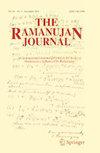Irrationality and transcendence questions in the 'poor man's adèle ring'.
IF 0.7
3区 数学
Q3 MATHEMATICS
引用次数: 0
Abstract
We discuss arithmetic questions related to the 'poor man's adèle ring' whose elements are encoded by sequences indexed by prime numbers, with each viewed as a residue in . Our main theorem is about the -transcendence of the element , where (Schur's q-Fibonacci numbers) are the (1, 1)-entries of -matrices
“穷人的ad圈”中的非理性与超越问题。
我们讨论了与“穷人ad环”A有关的算术问题,其元素由素数索引的序列(t p) p编码,每个t p被视为Z / p Z中的残数。我们的主要定理是关于元素(F p (q)) p的A -超越,其中F n (q)(舒尔的q-斐波那契数)是2 × 2矩阵1 1 1 1 1 1 1 q 0 1 1 q 2 0⋯1 1 q n - 20的(1,1)项,q > 1是一个整数。这个结果之前在GRH下是已知的qbbb101平方自由度。
本文章由计算机程序翻译,如有差异,请以英文原文为准。
求助全文
约1分钟内获得全文
求助全文
来源期刊

Ramanujan Journal
数学-数学
CiteScore
1.40
自引率
14.30%
发文量
133
审稿时长
6-12 weeks
期刊介绍:
The Ramanujan Journal publishes original papers of the highest quality in all areas of mathematics influenced by Srinivasa Ramanujan. His remarkable discoveries have made a great impact on several branches of mathematics, revealing deep and fundamental connections.
The following prioritized listing of topics of interest to the journal is not intended to be exclusive but to demonstrate the editorial policy of attracting papers which represent a broad range of interest:
Hyper-geometric and basic hyper-geometric series (q-series) * Partitions, compositions and combinatory analysis * Circle method and asymptotic formulae * Mock theta functions * Elliptic and theta functions * Modular forms and automorphic functions * Special functions and definite integrals * Continued fractions * Diophantine analysis including irrationality and transcendence * Number theory * Fourier analysis with applications to number theory * Connections between Lie algebras and q-series.
 求助内容:
求助内容: 应助结果提醒方式:
应助结果提醒方式:


